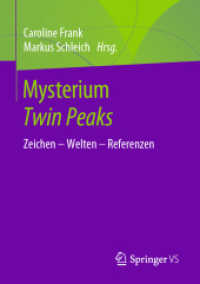- ホーム
- > 洋書
- > 英文書
- > Literary Criticism
Full Description
Why do so many contemporary British novels revert to the Victorian tradition in order to find a new source of inspiration? What does it mean from an ideological point of view to build a modern form of art by resurrecting and recycling an art of the past? From a formal point of view what are the aesthetic priorities established by these postmodernist novels? Those are the main questions tackled by this study intended for anybody interested in the aesthetic and ideological evolution of very recent fiction.
What this analysis ultimately proposes is a reevaluation and a redefinition of postmodernism such as it is illustrated by the British novels which paradoxically both praise and mock, honour and debunk, imitate and subvert their Victorian models. Unashamedly opportunistic and deliberately exploiting the spirit of the time, this late form of postmodernism cannibalizes and reshapes not only Victorianism but all the other previous aesthetic movements - including early postmodernism.
Contents
Introduction.
Part I: Pastiche, pastiche: the fascination of Victorianism.
Chapter 1: Victorian echoes: resurrected voices. The epigraphs, or the voices of the masters. The quotational practice: an aesthetic surplus. The derivative nature of pastiche. The parodic transformation of voices: depreciation or homage? The foregrounding of Victorian outcasts: the voices of postmodern fashion. When Victorian voices invade a whole novel...
Chapter 2: On the surface of the looking glass: an aesthetic and ideological model. 'The fascination of Narrative'. The metonymic pole. The documentary aspect. David Lodge's Nice Work: plus ça change... A.S. Byatt's Possession: 'making the past your world'.
Part II: Postmodernism as otherness: the temptation of revisitation.
Chapter 1: The parodic vein: ludic subversion. The disfigurement of the great Victorian figures. When playfulness becomes a guiding principle. Invigorating the new with the old: the regenerative art of parody in John Fowles's The French Lieutenant's Woman.
Chapter 2: Postmodern strategies of distanciation. An in-depth change of the surface. An aesthetics of the unsavoury. The delights of uncertainty. Fragmentation as the new consensus. The epitome of late twentieth-century postmodernist aesthetics: Graham Swift's Ever After.
Part III: Nostalgic Postmodernism: the paradox of an iconoclastic homage.
Chapter 1: The limits of subversion: the tyranny of the politically correct. The precedents of modernism and early postmodernism. Further qualifications and clarifications. A favourable climate or a profitable vein. Sex and crinolines: a combination aimed at seduction. How to be subversive and seductive at the same time: D.M. Thomas's Charlotte: The final journey of Jane Eyre.
Chapter 2: Postmodernism and the past: An ambiguous relation to the Victorian ancestors. An equivocal kinship. Nostalgic subversion: an oxymoric art. Evolution, not revolution: postmodernism as illustrated by retro-Victorian fiction. Conclusion. Works Cited. Index.







